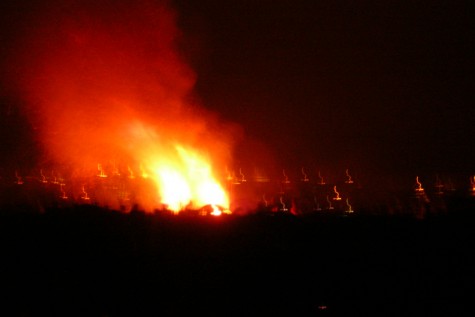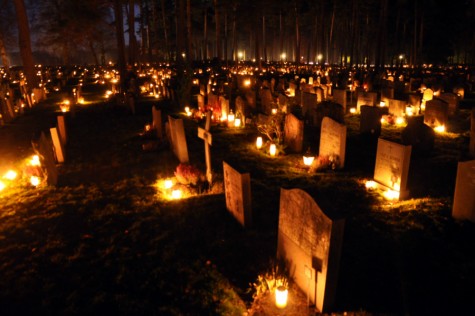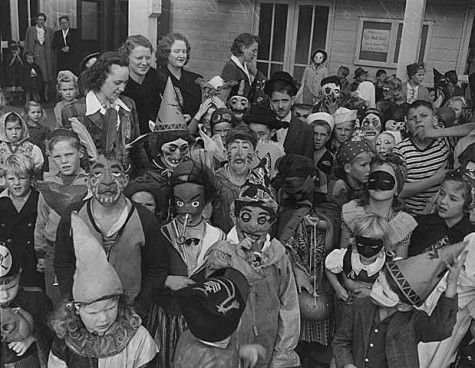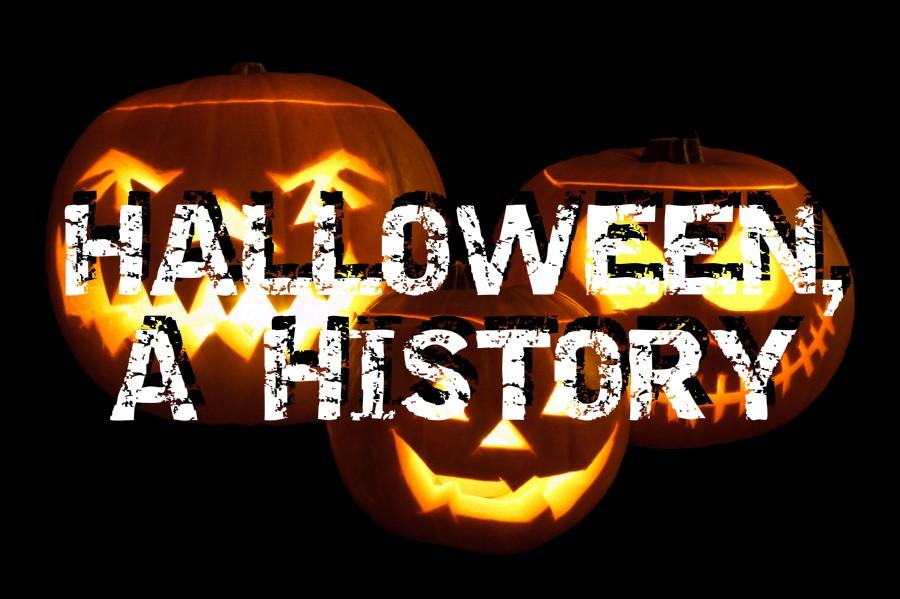IMAGE / Mr. William Warby / Modified by Katie Valley
Celtic Samhain inspires Halloween
October 30, 2015
Halloween, also known as All Hallows’ Eve, or All Saints’ Eve, is celebrated in a number of countries each year on Oct. 31.
Families and friends come together to go trick-or-treating, hand out candy to children in costumes, and/or throw the Halloween party of the decade.
According to theatlantic.com, Americans spent around $7.4 billion during Halloween last year, making the holiday the country’s second largest commercial holiday, coming after Christmas.
How did Halloween rise to its current glory?
Halloween derived from the 2000-year-old Celtic holiday, Samhain, meaning “summer’s end” in Gaelic, that took place Nov. 1. The Celts used the day to mark the end of the harvest season and the beginning of winter.
The night before, Oct. 31, was when people believed the dead returned as ghosts. To protect themselves against these spirits, people left food and wine on their doorsteps and, when leaving the house, wore masks to be mistaken as fellow ghosts.
The Celts also believed that on Oct. 31, Celtic priests, or the Druids, could more easily make predictions about the future, in particular the conditions the upcoming winter would bring.

Bonfires were a big part of the Samhain festival in many areas. This is a Beltane bonfire in Scotland.
To celebrate Samhain, the Druids built sacred bonfires in which people sacrificed animals and burned crops to appease the Celtic gods.
During this, people wore costumes made of animal heads and skins and told fortunes.
By around 43 C.E., The Romans had conquered much of the Celtic territory and ruled for the next 400 years. During this time, two Roman festivals were combined with the celebration of Samhain: Feralia and Pomona.
Feralia was a day in late October in which the Romans commemorated the dead. Pomona was a day that honored Pomona, the Roman goddess of fruit and trees.
In 609 C.E., Pope Boniface IV created the Catholic feast of All Martyrs’ Day in the western church, which was set to take place each year on May 13.
Christian Pope Gregory III then changed the name to All Saints’ Day in 835 C.E. to include saints in the celebration. He also moved the holiday from May 13 to Nov. 1.
All Saints’ Day incorporated some of the traditions of the Celts’ Samhain with Christian practices.
In the Eighth Century, the holiday became known as All Hallows’ Day. It was also sometimes called All-hallows or All-hallowmas.
The day before, Oct. 31, was then called All Hallows’ Eve, later shortened to Halloween.
In 1000 C.E., the Christian church recognized All Souls’ Day, which took place Nov. 2.

Protestant churches mourn the dead on All Souls’ Day.
All Souls’ Day was celebrated much like Samhain, with large bonfires, parades, and dressing up in costume.
On Nov. 2, respect was shown for the dearly departed.
Children and the poor begged for soul cakes, which are pastries made on the holiday to commemorate the dead. In return, they agreed to pray for an end to the plague, famine, and disease, along with praying for the deceased family members of the person who gave them the soul cake.
The begging for soul cakes was called souling.
The church endorsed the distribution of soul cakes as a means of replacing the tradition of leaving food and wine on doorsteps to appease roaming spirits.
Souling was common in Great Britain and Ireland, along with a second pre-existing form of trick-or-treating: guising.
Children would put on costumes and go up to peoples’ doorsteps singing songs, reciting poetry, and telling jokes to receive money, food, and wine.
Fast forward to colonial America, in which Halloween celebrations began because of the colonists’ newly found freedom from Protestant beliefs.
The first American celebrations of Halloween included “play parties,” in which the public would gather to celebrate the fall harvest. Neighbors would sing, dance, tell each others’ fortunes, and share stories of the dead.
The European traditions of souling and guising remained in Great Britain, Scotland, and Ireland up until the 19th Century, when, in America, Irish and Scottish immigrants brought forth the modernized idea of trick-or-treating. People would wear costumes and go house to house asking for money and food.
Tricks were the main focus trick-or-treating up until the 1950s when trick-or-treating took its place as a family-friendly means of Halloween fun.
The same Irish and Scottish immigrants also brought forth the jack-o-lantern.

Children in Halloween costumes at High Point, Seattle, 1943
The idea of the jack-o-lantern originated with the Irish folktale “Stingy Jack.”
According to that story, Stingy Jack tricked the devil into turning into a coin to pay for drinks.
Stingy Jack, using a cross in his pocket, kept the devil as the coin until the devil promised he would not bother Stingy Jack for one year. Later, Stingy Jack kept the devil stuck in a tree until he promised not to bother him for 10 more years.
As the legend says, when Stingy Jack died, he was not allowed into Heaven or Hell, and was sent off into the dark with only a burning coal to light his way, which Stingy Jack put into a carved-out turnip.
In Ireland and Scotland on All Hallows’ Eve, people would make their own versions of Stingy Jack’s lantern with turnips and potatoes carved with scary faces to ward away Stingy Jack and other evil spirits.
When these people immigrated to the United States, they saw pumpkins as the perfect fit for the jack-o-lantern.
Carving pumpkins soon became a norm for Halloween festivities.
In the late 1800s, there was a push to put more party into Halloween.
Celebrations became focused on costumes, games, and seasonal foods. Halloween began to lose much of its traditional, superstitious, religious roots and become a holiday about fun.
By the 1950s, Halloween became a holiday directed toward the young. Modern trick-or-treating began, in which a community would supply candy to neighborhood children so they would not play tricks, or reek havoc, on the adults.
Trick-or-treating remained a way for children to make the most out of their Halloween.
Many students enjoy Halloween and its festivities.
Junior Wiliam Spielmaker enjoys the holiday’s activities.
“I love Halloween because of candy, (hanging out with) friends, troublemaking, dressing up, Halloween parties, caramel corn” Spielmaker said. “It’s just an over-all fun time.”
There are still students that do not get into the Halloween spirit, however, like senior Alysa Figgins.
“I don’t really like it (Halloween) because when I was little I was afraid of it,” Figgins said. “It was like ‘devil’s night’ and I was afraid.”
Senior Jenny DeLong does not enjoy the aspects of Halloween festivities.
“I hate the kids that don’t know what lights off means when trick-or-treating,” DeLong said. “I also dislike the really offensive costumes such as Native American (American Indian) costumes and terrorist costumes.”
Halloween spirit is still in the hearts of a lot of students, especially Brandon Beldin, senior, who said that Halloween is one of his favorite holidays.
“I love the fact that people get to dress up and be whoever they want without people judging them for the night,” Beldin said. “Trick-or-treating is also fun. I find it pretty funny that (when trick-or-treating) you go up to strangers’ houses and get candy from these strangers despite being told your whole life not to do that.”
The featured image is from flickr.
